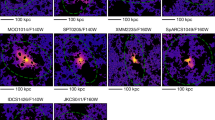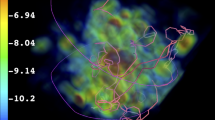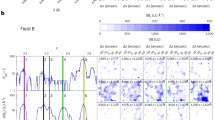Abstract
Unresolved anisotropies of the cosmic near-infrared background radiation are expected to have contributions from the earliest galaxies during the epoch of reionization1,2,3,4,5 and from faint, dwarf galaxies at intermediate redshifts6,7. Previous measurements8,9,10,11,12 were unable to pinpoint conclusively the dominant origin because they did not sample spatial scales that were sufficiently large to distinguish between these two possibilities. Here we report a measurement of the anisotropy power spectrum from subarcminute to one-degree angular scales, and find the clustering amplitude to be larger than predicted by the models based on the two existing explanations. As the shot-noise level of the power spectrum is consistent with that expected from faint galaxies, a new source population on the sky is not necessary to explain the observations. However, a physical mechanism that increases the clustering amplitude is needed. Motivated by recent results related to the extended stellar light profile in dark-matter haloes13,14,15, we consider the possibility that the fluctuations originate from intrahalo stars of all galaxies. We find that the measured power spectrum can be explained by an intrahalo light fraction of 0.07 to 0.2 per cent relative to the total luminosity in dark-matter haloes of 109 to 1012 solar masses at redshifts of about 1 to 4.
This is a preview of subscription content, access via your institution
Access options
Subscribe to this journal
Receive 51 print issues and online access
$199.00 per year
only $3.90 per issue
Buy this article
- Purchase on Springer Link
- Instant access to full article PDF
Prices may be subject to local taxes which are calculated during checkout



Similar content being viewed by others
References
Santos, M. R., Bromm, V. & Kamionkowski, M. The contribution of the first stars to the cosmic infrared background. Mon. Not. R. Astron. Soc. 336, 1082–1092 (2002)
Salvaterra, R. & Ferrara, A. The imprint of the cosmic dark ages on the near-infrared background. Mon. Not. R. Astron. Soc. 339, 973–982 (2003)
Cooray, A., Bock, J. J., Keating, B., Lange, A. E. & Matsumoto, T. First star signature in infrared background anisotropies. Astrophys. J. 606, 611–624 (2004)
Kashlinsky, A., Arendt, R., Gardner, J. P., Mather, J. C. & Moseley, S. H. Detecting population III stars through observations of near-infrared cosmic infrared background anisotropies. Astrophys. J. 608, 1–9 (2004)
Fernandez, E. R., Komatsu, E., Iliev, I. T. & Shapiro, P. R. The cosmic near-infrared background II: fluctuations. Astrophys. J. 710, 1089–1110 (2010)
Chary, R., Cooray, A. & Sullivan, I. Contribution to unresolved infrared fluctuations from dwarf galaxies at redshifts of 2–3. Astrophys. J. 681, 53–57 (2008)
Helgason, K., Ricotti, M. & Kashlinsky, A. Reconstructing the near-IR background fluctuations from known galaxy populations using multiband measurements of luminosity functions. Astrophys. J. 752, 113 (2012)
Kashlinsky, A., Arendt, R. G., Mather, J. & Moseley, S. H. Tracing the first stars with fluctuations of the cosmic infrared background. Nature 438, 45–50 (2005)
Cooray, A. et al. IR background anisotropies in Spitzer GOODS images and constraints on first galaxies. Astrophys. J. 659, L91–L94 (2007)
Thompson, R., Eisenstein, D., Fan, X., Rieke, M. & Kennicutt, R. C. Evidence for a z 8 origin of the source-subtracted near-infrared background. Astrophys. J. 666, 658–662 (2007)
Matsumoto, T. et al. AKARI observation of the fluctuation of the near-infrared background. Astrophys. J. 742, 124 (2011)
Kashlinsky, A. et al. New measurements of the cosmic infrared background fluctuations in deep Spitzer/IRAC survey data and their cosmological implications. Astrophys. J. 753, 63 (2012)
Purcell, C. W., Bullock, J. S. & Zentner, A. R. Shredded galaxies as the source of diffuse intrahalo light on varying scales. Astrophys. J. 666, 20–33 (2007)
Purcell, C. W., Bullock, J. S. & Zentner, A. R. The metallicity of diffuse intrahalo light. Mon. Not. R. Astron. Soc. 391, 550–558 (2008)
Conroy, C., Wechsler, R. H. & Kravtsov, A. V. The hierarchical build-up of massive galaxies and the intracluster light since z = 1. Astrophys. J. 668, 826–838 (2007)
Ashby, M. L. N. et al. The Spitzer Deep, Wide-field Survey. Astrophys. J. 701, 428–453 (2009)
Arendt, R. G., Fixsen, D. J. & Moseley, S. H. Dithering strategies for efficient self-calibration of imaging arrays. Astrophys. J. 536, 500–512 (2000)
Jannuzi, B. T. & Dey, A. in Photometric Redshifts and the Detection of High Redshift Galaxies (eds Weymann, R., Storrie-Lombardi, L., Sawicki, M. & Brunner, R.) 111–116 (ASP Conf. Ser. Vol. 191, Astron. Soc. Pacif., 1999)
Cooray, A., Gong, Y., Smidt, J. & Santos, M. G. The near-IR background intensity and anisotropies during the epoch of reionization. Astrophys. J. 756, 92 (2012)
Fernandez, E. R., Iliev, I. T., Komatsu, E. & Shapiro, P. R. The cosmic near infrared background. III. Fluctuations, reionization, and the effects of minimum mass and self-regulation. Astrophys. J. 750, 20 (2012)
Madau, P. & Silk, J. Population III and the near-infrared background excess. Mon. Not. R. Astron. Soc. 359, L37–L41 (2005)
Cooray, A. & Sheth, R. Halo models of large scale structure. Phys. Rep. 372, 1–129 (2002)
Tal, T. &. van Dokkum, P. The faint stellar halos of massive red galaxies from stacks of more than 42000 SDSS LRG images. Astrophys. J. 731, 89 (2011)
Lin, Y. & Mohr, J. J. K-band properties of galaxy clusters and groups: brightest cluster galaxies and intracluster light. Astrophys. J. 617, 879–895 (2004)
Rudick, C. S., Mihos, J. C., Frey, L. H. & McBride, C. K. Tidal streams of intracluster light. Astrophys. J. 699, 1518–1529 (2009)
Gonzalez, A. H., Zabludoff, A. I. & Zaritsky, D. Intracluster light in nearby galaxy clusters: relationship to the halos of brightest cluster galaxies. Astrophys. J. 618, 195–213 (2005)
Levenson, L. R., Wright, E. L. & Johnson, B. D. DIRBE minus 2MASS: confirming the CIRB in 40 new regions at 2.2 and 3.5 microns. Astrophys. J. 666, 34–44 (2007)
Amblard, A. et al. Submillimetre galaxies reside in dark matter haloes with masses greater than 3 × 1011 solar masses. Nature 470, 510–512 (2011)
Carollo, D. et al. Structure and kinematics of the stellar halos and thick disks of the Milky Way based on calibration stars from Sloan Digital Sky Survey DR7. Astrophys. J. 712, 692–727 (2010)
Courteau, S. et al. The luminosity profile and structural parameters of the Andromeda Galaxy. Astrophys. J. 739, 20 (2011)
Acknowledgements
We acknowledge support from NSF CAREER (to A.C.), NASA ADAP and an award from JPL/Caltech. We thank R. Arendt for sharing his IRAC self-calibration code. We thank J. Bock and M. Zemcov for their contributions to the SDWFS project. This work is based on observations made with the Spitzer Space Telescope. This work also made use of data products provided by the NOAO Deep Wide-Field Survey. A.C. thanks the Aspen Center for Physics for hospitality.
Author information
Authors and Affiliations
Contributions
A.C. planned the study, developed the IHL model, supervised the research work of J.S., F.D.B., C.C.F. and Y.G., and wrote the draft version of this paper. J.S. and C.C.F. performed the power spectrum measurements and F.D.B. interpreted those measurements with a halo model for the IHL. Y.G. developed a model for the high-redshift galaxies. All other co-authors contributed extensively and equally by their varied contributions to the SDWFS project (led by D.S. as the Principal Investigator), planning of SDWFS observations, analysis of SDWFS data, and by commenting on this manuscript as part of an internal review process.
Corresponding author
Ethics declarations
Competing interests
The authors declare no competing financial interests.
Supplementary information
Supplementary Information
This file contains Supplementary Text and Data 1-8, Supplementary Figures 1-13, Supplementary Table 1 and additional references. (PDF 2380 kb)
Rights and permissions
About this article
Cite this article
Cooray, A., Smidt, J., De Bernardis, F. et al. Near-infrared background anisotropies from diffuse intrahalo light of galaxies. Nature 490, 514–516 (2012). https://doi.org/10.1038/nature11474
Received:
Accepted:
Published:
Issue Date:
DOI: https://doi.org/10.1038/nature11474
This article is cited by
-
Heliocentric distance dependence of zodiacal light observed by Hayabusa2#
Earth, Planets and Space (2023)
-
Measurement of the cosmic optical background using the long range reconnaissance imager on New Horizons
Nature Communications (2017)
-
Ultraviolet luminosity density of the universe during the epoch of reionization
Nature Communications (2015)
-
Reionization and the Cosmic Dawn with the Square Kilometre Array
Experimental Astronomy (2013)
-
Behind the mask
Nature Physics (2012)
Comments
By submitting a comment you agree to abide by our Terms and Community Guidelines. If you find something abusive or that does not comply with our terms or guidelines please flag it as inappropriate.



